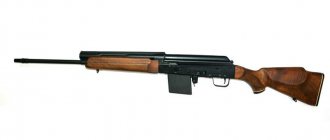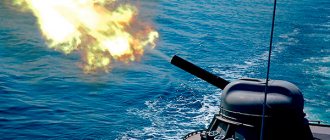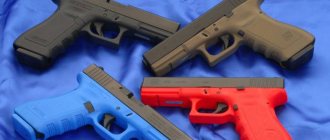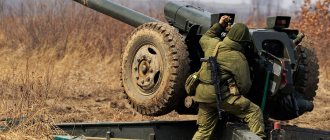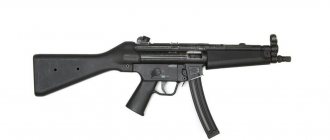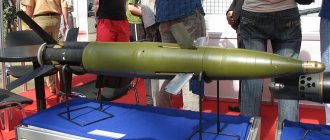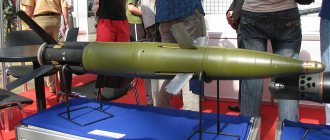Sokol is the oldest of all Russian smokeless powders; it began to be used in 1937. However, the gunpowder that is now produced according to GOST 1977 is noticeably different from its predecessor, since both the composition of the gunpowder and the requirements for it have changed. At the moment, this is one of the most popular gunpowders, meeting all international standards in its characteristics.
The Falcon is not used only in gas-operated hunting rifles with a fixed barrel, due to sparking as a result of the emission of unburned particles.
Unlike Sunar, Sokol is not so demanding on weights and can forgive errors in calculations, although the requirements for it are the same - weighing accuracy up to 0.05 grams. In addition, a novice self-loader will find it much easier with this type of charge. Because there are a lot more manuals out there about how much powder to put in and what to do next.
Characteristics of Sokol gunpowder
Gunpowder is produced in plates having a rectangular shape. Their base is nitrocellulose. This powder is stable, has a stable chemical composition, and does not stick together.
The surface of the plates is graphitized and gelled (just to protect it from sticking and electrification). Length varies from 1.28 to 1.7 mm, thickness 0.13 mm.
Gunpowder is produced in two grades - highest and first. How much gunpowder is in a pack? Release form: tin cans of 200-250 grams. If you purchase the option in a galvanized box, then its weight is 45-50 kg. How long will the gunpowder be stored? When properly stored in cans, gunpowder does not lose its properties for about 6 years, in a galvanized box - 25.
Today, Sokol is used by many domestic manufacturers of cartridges, for example, Azot, Fetter, Poliex and others.
Loading cartridges with a wad container
This method is a little simpler than the previous one, since it eliminates the need to use a powder gasket and wads. This entire structure is replaced by just one wad container, which, in addition to everything else, increases the accuracy of the battle.
To do this, we need a regular paper or plastic cartridge case with a 12-gauge Zhevelo capsule, Sokol gunpowder, a wad container, respectively, 32 grams of shot and only one shot spacer with a thickness ranging from 0.5 to 1 mm.
- We take a regular cartridge case under the Zhevelo primer and add 2 grams of Sokol gunpowder there.
- Next, we take the wad container itself and send it to the gunpowder.
- Pour 32 grams of shot into this container.
- We put a regular shot gasket and tighten it with a twist.
This cartridge is loaded. Everything is quite simple and without any unnecessary steps.
Falcon's hitch
This is a real headache for many hunters. The fact is that the manufacturer still does not know or does not want to know about the emergence of modern materials. Therefore, his recommendations regarding how much gunpowder per charge date back to 1977. Therefore, the packages contain not entirely up-to-date information. Many hunters determine how much powder to load on their hunting rifles through trial and error. However, the earth is full of craftsmen, and they have repeatedly carried out tests to determine the maximum measure of gunpowder. Research was carried out on RC4 70 mm cartridges, KV-209 capsule, and star-type container.
The results are:
Regardless of the series, the characteristics of the gunpowder are approximately the same.
How much gunpowder is needed for non-Magnum cartridges:
| caliber | hitch | powder |
| 12 gauge | shot weighed 28 grams | 1.9 gr. |
| 12 gauge | shot weight 32 grams | 2.1 gr. |
| 12 gauge | shot weighed 35 grams | 2.25 gr. |
| 12 gauge | shot weighed 40 grams | 2.4 gr. |
| 16 gauge | shot weighed 28 grams | 1.6 gr. |
| 16 gauge | shot weight 29 grams | 1.7 gr. |
| 16 gauge | shot weighed 30 grams | 1.8 gr. |
| 20 gauge | shot weighed 22 grams | 1.4 gr. |
| 20 gauge | shot weighed 23 grams | 1.5 gr. |
| 20 gauge | shot weighed 24 grams | 1.6 gr. |
How much powder should be loaded for Magnum cartridges:
| caliber | hitch | powder |
| 12 gauge | for 40 grams of charge | for cartridge cases chambered for Magnum - 2.8 g. |
How much powder to use for bullets:
| caliber | bullet | powder |
| 20 gauge | Polev bullet 3 | hitch 2.0 |
| 20 gauge | Polev bullet 7 | hitch 2.0 |
| 20 gauge | Shashkov bullet | hitch 2.2 |
| 16 gauge | hitch 2.1 | |
| 16 gauge | Brenneke bullet | hitch 2.0 |
Independent loading of 12, 16 and 20 gauge cartridges
Falcon is an ideal option for loading cartridges on your own, in the case when the factory samples do not satisfy you with the accuracy of fire, other characteristics, or you are going on some important hunt.
The procedure for loading 12, 16 and 20 gauge cartridges:
- Need a lot of free space a. Remove all unnecessary items from your table/workbench. Place empty cartridges on the left, tools in the center or in your hands, and primers on the right.
- We calibrate the sleeves . If there is no caliber, we use our hunting rifle. If you skip this step, you won't have any problems.
- Decapsulating the cartridges.
- We insert the primers into the cases manually.
- We press the capsules with the UPS until they stop.
- We remove everything from the table except the prepared cartridges.
- Now you need to get the weighing devices. The ideal tools for measuring are special electronic scales, since even pharmacy analogues are too inaccurate for measuring ammunition. Let's talk about weighing. The recommended measurement for powder weight is the total weight of the wads, shot and spacers, but not just the shot separately. Don't forget this when taking measurements.
- We place the scales in front of us, the jar with the Falcon on the right. You can weigh in any container convenient for you (don’t forget to subtract how much it weighs).
- To add gunpowder, experienced cartridge loaders recommend using a sheet of paper, so nothing will spill on the table.
Pour the Falcon into the cartridge case and move it to the left. This way you can avoid charging the same cartridge twice. Even if we did not notice the “overcharge,” then later it will be easy to find out how much was overfilled.- Now we catch up with the wad using a special device, and we do this without lifting the elbow from the table; the cartridge must stand on a special stand that prevents accidental puncture of the primer, and, accordingly, accidental detonation of gunpowder. If the wad is greasy, then we install cardboard spacers; if it is polyethylene, then we do not install it.
- Now we close the sleeves with containers .
- We push the containers into the sleeve . You don't need to press hard, gunpowder doesn't like that in any caliber, be it 12, 16 or 20. You'll develop muscle memory pretty quickly. In addition, the “overloading” of the cartridge is easy to see by the non-standard position of the wad. Dust-filled cartridges can be safely stored.
- We make a shot measure from a trimmed cartridge case (very convenient and allows you not to weigh the shot every time before loading). The height of this measure should be such that the required volume of shot fits into it completely and without slides. You can make several of these measurements if you plan to equip the cartridges with different amounts of shot.
- Now you can pour the shot into the cartridge case and press it properly with a hammer. When loading, the shot must be properly compacted, as otherwise the accuracy of fire and scree will suffer.
- If there is no special stand for cartridges, then it is better to carefully put the cartridges somewhere. For 12, 16, 20 gauge cartridges, the center of gravity is shifted upward, and by hook or by crook they tend to fall and knock down the rest.
- We form an “asterisk” and press the cartridge with a matrix . If the height has been chosen correctly, then the “star” will perfectly merge with the edges, without cracks or other defects, and will also fit tightly to the table. If the surface is humped - there is a lot of shot, if it falls - not enough.
- Now we insert the cartridge into the twist and make a side of 1-1.5 mm. Without this side, after some time, a 12, 16, 20 caliber cartridge may open up.
- The cartridge is ready!
If you took the wrong measurement and the “Star” did not work out, then you can use simple twists. Both cardboard and cut parts of wad containers are suitable for this. In this case, the twisting will be noticeably simplified, and the cardboard spacers can also be signed. It is worth signing and marking cartridges with a nitro marker; it is clearly visible both day and night, and besides, it can be used to mark not only the cardboard spacer, but also the 12, 16, 20 gauge cartridge itself. As you can see, there is nothing complicated about equipping cartridges.
Loading 12, 16 and 20 gauge cartridges with Sokol gunpowder
In another article, we have already described in detail how to properly load 12-gauge cartridges, using, among other things, “Falcon” gunpowder (smoky or smokeless). In a nutshell, you will need the following:
- UPS (Sidorenko universal device);
- machine for rolling sleeves;
- scales for determining the mass of gunpowder and shot;
- navoynik for sending wads;
- calibration ring to check the size of the cartridge.
The gunpowder must be pre-weighed.
As additional tools, it is also recommended to use a dispenser (so as not to constantly weigh gunpowder and shot), a funnel (for convenient pouring gunpowder and shot into the cartridge), and also a die cutter (for making wads yourself). The equipment process is as follows:
- We select whole spent cartridges - it is important that they are not deformed.
- We remove the old capsule using the Sidorenko universal device.
- We install a new capsule into the cartridge using the UPS.
- We load gunpowder into the cartridge case, having previously measured out the required amount.
- We send the wad and gasket into the cartridge using a navoynik.
- We load the fraction after first weighing it on the scales.
- We roll the cartridge using a machine.
- We use a calibration ring to check the size of the cartridge (whether it sticks out).
- We mark the ammunition so as not to forget about its weight.
A cartridge loaded with your own hands is not only a guarantee of high ballistic characteristics, but also good savings. After all, the cost of ammunition in gun stores (especially imported) leaves much to be desired. If you buy all the components separately and do all the work yourself, you will be able to save a significant amount.
Flaws
Shooters planning to use Bars gunpowder need to know its disadvantages.
- Users noted a relatively low range of deviations when weighing: it should not exceed 0.03 g from the recommended norm.
- When making a cartridge, it is impossible to use measuring containers. This is due to the fact that the density of the mixture is non-standard. Deviations of this parameter were also recorded in different batches of gunpowder.
- The use of Bars gunpowder is limited to 12-, 16- and 20-gauge shotguns. Using it in smaller models risks destroying them.
- Experienced hunters note the negative impact of this gunpowder on the accelerated wear of cartridges: they last for fewer shots than when using other compounds.
- Since Bars gunpowder is a nitroglycerin type of mixture, its combustion temperature is several hundred degrees higher than that of pyroxylin analogues. This can cause the gun to wear out faster.
In addition to the described disadvantages, such gunpowder requires special storage conditions and the use of special primers.
What does 16 gauge mean?
The bore of the 16 caliber is 16.8 mm. Weapons that meet this parameter are characterized by light weight, which is especially appreciated when conducting sea fishing.
To get a 16 gauge bullet, you need to take 453.59 g or 1 English pound of lead and divide it into 16 equal parts. After this, elements identical in all respects are cast from the material.
The diameter of the resulting lead ball must correspond to the internal diameter of the weapon barrel.
Key Benefits
16 gauge hunting cartridges have many positive aspects that have been appreciated. Many people prefer them for their moderate stopping power combined with good shot spread.
The 16 gauge cartridge successfully combines the main characteristics that are important when choosing ammunition. We are talking about its power, weight, sharpness and spread.
The 16 gauge shotgun is intended for running fishing. It does not cause any inconvenience to a person, as it has a relatively light weight and compact dimensions. Despite this, such weapons are capable of killing wild boar and even elk.
The weapon, which is loaded with 16-gauge cartridges, is distinguished by its aesthetics and elegance.
Main disadvantages
Specialized stores do not always have a large selection of 16-gauge ammunition.
The 16-gauge cartridge has not only positive, but also negative aspects that also need to be taken into account. We are talking about the following important points:
- The filling of buckshot and shot is small, which reduces the affected area during shooting.
- The chances of hitting the target are reduced for the reason described in the first paragraph.
- Small variety of ammunition available.
Advantages
In addition to the general positive aspects characteristic of any smokeless powder, Bars also has its own advantages.
- Dense composition (1.7 - 1.8 times higher than that of the Sokol composition). Its particles have a spherical shape. This allows the use of a smaller volume of gunpowder in the manufacture of cartridges.
- Bars gunpowder is a nitroglycerin type of smokeless gunpowder. When burned, it emits less gases than pyroxylin analogues.
- Comparative ease of manufacture. This makes the price of Bars more affordable than its analogues.
- Compared to the "Falcon", it, as a rule, provides a higher initial speed of flight of a bullet or shot.
- It was the combination of these advantages that prompted many hunters to create large reserves of this gunpowder. Despite the fact that it is not sold today and has been replaced by more modern mixtures, many users still talk about using Bars produced in the 80s and 90s.
Dope for the patron
Modernization of cartridges for small arms.
Since the invention of the unitary cartridge, a great variety of ammunition has appeared for various weapons and intended for a wide range of tasks. In 1861, the Frenchman Potte invented the first unitary central ignition cartridge. The Englishman Boxer did a lot to improve centerfire cartridges. In particular, it was he who replaced the paper sleeve proposed by Potte with a metal one.
A typical unitary cartridge for small arms, the appearance of which was formed in the middle of the 19th century, has an igniter primer, a powder charge, a metal sleeve and a bullet. However, it is clear that in the 150–170 years that have passed since the advent of unitary cartridges, repeated attempts have been made to improve them. In particular, the design of a high-speed rifled cartridge with a separated powder charge and an igniter primer of increased reliability deserves attention. With an increase in initial speed, the flight time of the bullet is reduced, which helps improve shooting accuracy due to the reduction in the influence of errors in the preparation of initial data. An increase in the initial speed of a bullet is accompanied by an improvement in the flatness of the trajectory and an increase in the range of a direct shot, making it easier to use the weapon due to the possibility of shooting at a constant sight. At the same time, the speed and kinetic energy of the bullet at the target increases and its lethal and penetrating effect improves. It is possible to increase the flight speed of a bullet by increasing the total mass of the propellant charge without increasing the maximum pressure of powder gases in a cartridge for rifled weapons with a cylindrical sleeve with a relative elongation of at least 2.7 by placing in the sleeve a second additional part of the powder charge, separated from the main powder charge by a diaphragm with hole. In this case, the diaphragm must be placed inside the sleeve with interference and have an initial diameter of 0.05–0.2 mm larger than the inner diameter of the sleeve.
Diagram of a cartridge with a split charge for rifled weapons: 1 - cartridge case, 2 - igniter primer, 3 - main powder charge, 4 - diaphragm, 5 - powder charge, 6 - bullet
Increasing the reliability and reducing the response time of the igniter primer when firing from long-barreled rifled weapons can be achieved by the fact that in the igniter primer, consisting of a metal cap with an impact-action ignition composition pressed into it, covered with a sealing membrane, there is a dome-shaped three-lobe anvil, which at the top its dome is in close contact with the sealing membrane, and the bases of the anvil petals rest against the inner wall of the cap of the primer-igniter and are in close contact with a special annular protrusion located in the primer socket of the cartridge case. In this case, the diameter of the annular protrusion is less than the diameter of the primer hole by the amount of four times the wall thickness of the igniter cap plus 0.15 mm.
Scheme of a primed sleeve: 1 - sleeve; 2 - metal ball; 3 - capsule socket; 4 — metal cap; 5 - impact ignition composition; 6 - sealing membrane; 7 — hole in the bottom of the capsule socket; 8 - three symmetrically located circumferential undercuts for the flow of detonation products of the ignition composition of the impact action to the powder charge on the inner surface of the central hole in the bottom of the primer socket
This design of the igniter primer and the presence of a special annular protrusion in the primer socket of the cartridge case leads to an increase in the rigidity of the impact of the weapon’s firing pin on the percussion-ignition composition, since the anvil rests on a special annular protrusion, which prevents possible shifting of the cap of the igniter primer when the striker hits. In addition, this design of the shell with a bend allows, even in the case when the anvil is pressed inside the cap not exactly with tolerances of 0.05-0.1 mm, to always firmly rest it on a special annular protrusion in the capsule socket of the sleeve, which will lead to tight pressing of the anvil dome to the impact-ignition composition through the sealing membrane. The disadvantage of the design is the technological complexity of the three-leaf anvil.
But it is possible to simplify the design - instead of a three-lobed anvil, use a metal ball, which is adjacent to the sealing membrane on one side and to the bottom of the capsule hole with the other, partially placed inside the central hole in the bottom of the capsule socket, and has such a diameter that it is somewhat recessed in the capsule socket relative to the end of the case head.
With this solution, the labor intensity of manufacturing is reduced, and, consequently, the cost is reduced, the reliability of the firing of the primer is increased, and the sensitivity and stability of the firing of the primer as part of the cartridge is increased.
When priming cartridges in automatic mode on special lines, it will be necessary to place additional equipment on them - a metal ball feeder - which will feed metal balls to the central hole in the bottom of the capsule socket of the cartridge case. This hole will reliably fix the position of the metal ball during the further automatic operation of pressing in metal caps with an impact ignition composition pressed into them, covered with a sealing membrane.
The sleeve of the new design will perform excellently as part of a high-speed rifled cartridge, where a certain time delay is provided for the ignition of an additional part of the powder charge, which allows increasing the total mass of the propellant charge and the flight speed of the bullet projectile.
TKM-366 cartridges were reloaded with Sunar 410 gunpowder with the powder charge divided into two equal parts by a cardboard spacer
In such a cartridge, the combustion of the second part of the powder charge, the mass of which is selected experimentally, no longer causes an increase in the level of maximum pressure of the powder gases, because at the moment of its ignition the bullet is already moving and the volume of the bullet space in the barrel increases sharply.
Due to the fact that the relative elongations of cylindrical cartridge cases for rifled weapons are close to the relative elongations of cylindrical cartridge cases for smooth-bore guns, for which the principles of increasing the flight speed of the thrown element due to the division of the powder charge into parts by diaphragms with holes have been well studied (RF patents No. 2102693, No. 102103, No. 2301954, No. 143745, No. 2512815, No. 2522753), it can be assumed that this principle of increasing the speed of a bullet will also be applicable to rifled cartridges.
To substantiate this statement, we can cite the results of ballistic tests of a .410-caliber bullet cartridge. The Barnaul Cartridge Plant carried out work to modernize the .410-caliber bullet cartridge with a steel sleeve. It differs from the standard one in that it has a divided powder charge (Sunar-410) that has increased in mass by 30%. By analogy with the results of a similar modernization of the 12-gauge bullet cartridge, it was expected that the average speed would increase by 70-80 m/s, the average maximum pressure would increase slightly, the decrease in trajectory at a distance of 100 m would be less than that of the standard cartridge, and the accuracy of fire would be higher. The latest serial cartridges were loaded with Sunar-410 gunpowder, batch 1-05K (charge weight 1.39 g). The total charge for experimental .410 caliber cartridges with a divided powder charge was 1.8 g (main charge 1.2 g).
Results of firing the .366 TKM cartridge with a split powder charge, distance 100 m from VPO-208
Analysis of the shooting results showed the following. For modernized .410 caliber cartridges with a split powder charge: V10 = 580 m/s, bullet velocity spread - 33 m/s, Pmax = 929 kgf/cm2. Accuracy of fire at 35 m is 11.5 cm (diameter), at 100 m - 31 cm.
For standard cartridges V10 = 496 m/s, velocity spread - 19 m/s, Pmax = 825 kgf/cm2, accuracy of fire at 35 m - 15 cm; shooting accuracy at a distance of 100 m is 64.5 cm.
Thus, a modernized cartridge with a divided powder charge at almost the same maximum pressure as a standard cartridge exceeds it in speed by 17%, and in accuracy at 100 m - by 2 times.
This cartridge used Sunar-410 gunpowder for the main and additional charges. However, if we draw an analogy with ballistic studies on the effectiveness of using a divided powder charge for smooth-bore cartridges, set out in RF patents No. 102103 and No. 14374, where the feasibility of using different brands of gunpowder for the main and additional charges has been proven, then the results obtained can be improved.
Results of firing a cartridge with a split powder charge from VPO-208 into a steel plate. The crater depth was 4.4 mm
In this aspect, it is interesting to consider the new domestic cartridge .366 TKM (). Weapons of this caliber (VPO-208, VPO-209) belong to smooth-bore weapons, although their parameters at ranges up to 100 m are close to rifled ones. The VPO-208 carbine can withstand the operating pressure of the TKM-366 cartridge at 3300 bar, which exceeds the maximum pressure of the powder gases of a smooth-bore weapon by more than 3 times. The diameter of bullet dispersion when firing from the VPO-208 at 50 and 100 m is practically at the level of a rifled weapon. The successful use of a split charge in this cartridge can ideally demonstrate the versatility and practicality of using split charges in rifled cartridges, including live ones, for small arms.
For full-scale testing of cartridges with a split powder charge in caliber .366 TKM, cartridges with a DERI bullet (weight 13.5 g), which provide an initial speed of 550 m/s, were purchased and loaded. Then, using cartridges and bullets, cartridges of the same caliber were reloaded, but with Sunar 410 gunpowder and with the powder charge divided by a cardboard spacer into two equal parts (0.75 + 0.75 g).
The average initial velocity of ten shots from the VPO-208 with cartridges with a divided powder charge was 636 m/s. This speed is 14% higher than the speed of a standard cartridge with a DERI bullet and, therefore, the kinetic energy of a cartridge bullet with a separated powder charge is almost 30% higher than the energy of a standard factory cartridge bullet. The maximum pressure, determined by the collapse of the igniter primer of the modernized cartridge, turned out to be at the level of the standard cartridge.
In addition, they fired at point-blank range into a steel plate using standard DERI bullet cartridges and cartridges with a split powder charge. The depths of the craters were determined, which for a standard cartridge and a cartridge with a divided powder charge, respectively, amounted to 3.6 and 4.4 mm.
Thus, the possibility of increasing the efficiency of shooting from hunting weapons of .366 TKM caliber through the use of a cartridge with a split charge has been proven, and nothing prevents the establishment of its mass production. Perhaps such a cartridge will appear soon...
16 gauge is a great choice
photo: Anton Zhuravkova
Several years ago, even in Moscow, it was difficult to find 16-gauge cartridges with the required shot number. Now the situation is changing for the better, they have again begun to produce sixteen-gauge shotguns, and almost every major cartridge manufacturer has a sixteen-gauge line in their assortment.
However, how do specific brands of cartridges perform on various hunts?
All of the following is a purely subjective opinion, formed as a result of the actual use of two sixteen-caliber shotguns on various hunts (IZH-27E, produced in 1990, the upper barrel is chock, the lower one is payload, and “Bekas-3”, produced in 1999, with two interchangeable barrels - one long 500 mm (cylinder), the other - 730 mm with three interchangeable muzzle bushings - choke, choke, cylinder).
SUMMER HUNTING SWAMP-MEADOW GAME
Every year, at the end of August, I go to the Ryazan region to hunt. Vast meadows and swamps provide excellent refuge for snipe, corncrakes and snipes. The hunting pressure in those places is low - local residents do not consider “small things” to be game, and visiting hunters are more interested in ducks, often without even imagining what kind of game is found in the swamp. Since I don’t have a dog, the only hunting available in this case is with a self-propelled gun.
Such a hunt places special demands on ammunition: if the object of the hunt is a snipe, which rarely allows the hunter closer than eighteen to twenty meters, then a compact shot with uniform scree is required, the game is small and even small “windows” in the scree at such a distance can easily “enclose” the bird ; if the corncrake is the opposite situation, since the twitch sits very tightly and you often have to shoot from a distance of seven to eight meters, accordingly, the fight needs to be as spread out as possible, otherwise when you get home there will be nothing to carry except a couple of feathers.
Initially, I used the IZH-27 on this hunt, and then switched to the Bekas with a short barrel - it is much lighter and turns faster than the IZH, and I don’t often have to shoot twice in a row on this hunt.
Snipe.
The cartridges used were “Taiga” with shot Nos. 10 and 9, “Record” with No. 9, “Nitrogen” with No. 9, “Rio” (Spain) with shot No. 9, self-loaded cartridges with 28 g of shot No. 9 (gunpowder “ Falcon”, shot – in a domestically produced wad container).
The “Rio” cartridges turned out to be the worst - with them only one snipe was caught from a distance of about eighteen meters, the other five or six shots were ineffective. Probably the reason for the misses was the poor quality of the container wads used in these cartridges - I managed to find two of them, one had a deformed seal, and the other had two torn container petals.
I didn’t use these cartridges anymore on the hunt; the remainder were shot on a stand at a “Rabbit” target from a distance of ten to twelve meters - the number of broken targets did not differ from other brands of cartridges used. The shot is quite comfortable, the recoil is moderate. Once there was a delay in the Bekas - the ejector hook jumped off the edge, and the cartridge case could only be removed with a cleaning rod.
During operation, it turned out that Bekas “does not like” imported cartridge cases with a brass base - after a shot, all the metal parts of the case, including the rim, swell a little, it becomes flatter and the ejector tooth slides off it. On average, such a delay occurs once every 10 shots. The situation improved somewhat after filing the tooth, but I have not yet been able to find a radical solution.
I managed to achieve the best result with “Taiga” - I think the 10th number of the fraction played an important role. The snipe fought deathly at a distance of up to twenty-five to thirty meters (I didn’t shoot further). In total, about a dozen birds were caught. The misses were solely the fault of the shooter. An excellent cartridge, with the exception of the already mentioned problem with the brass base of the case - it is better to use it in “breakdowns”. True, it seems that Taiga has problems - recently it is almost impossible to find cartridges of this brand.
The rest of the cartridges showed approximately the same results - there were, of course, more misses than with the "Taiga" ten, but, nevertheless, it is not possible to clearly give the palm to the championship. The Record had one misfire in the lower barrel of the IZH-27 (it fired during repeated use - apparently, the problem was in the seating depth of the primer, since the puncture from the first shot was deep), and the Azot had the already described problems with the hook.
If you choose based on efficiency criteria, then Taiga comes first. If price is important to you, then “Record” or “roll-your-own” (especially if loaded with spent cartridges). However, the “Record” has one drawback, which, if you are not careful, can result in damage to the barrel - many batches of cartridges use rather strange “Zhevelo” primers - after the shot, the primer flares out and the anvil flies into the barrel.
| photo: Semina Mikhail |
As a rule, it flies right through, but once I found it lying in front of the choke in the barrel after a shot. If I had not blown out the barrel after each shot, it could well have caused local swelling of the barrel. You need to be especially careful when using it in a repeating weapon - you can’t visually check the barrel there. For those who reuse spent cartridges, such cartridges also pose a certain problem - knocking out such a primer without deforming the cartridge is very difficult.
Great snipe.
The statistics for the great snipe are extremely low, with only three trophies. Two were taken at a distance of about twenty meters by “Rekord” with shot No. 9 (from the first shot), one was taken at a distance of about 35 meters by the “Nitrogen” cartridge with shot 7.5 (by the second shot from the IZH-27 choke, the first shot missed , a “self-twisting” cartridge with shot No. 9 from a distance of twenty-five meters).
Landrail
– this is my most common catch. Initially, I used IZH-27 with shot No. 8–9 of various types, “Azot”, “Pozis”, “Taiga”), but shots at corncrakes at close range smashed the game so badly, and letting go of a flying corncrake farther away does not always have enough endurance that I completely switched to my own cartridges.
A charge of Sokol gunpowder is poured into the cartridge case, reduced by 0.1 grams from the maximum indicated on the packaging, then a polymer seal is added, a wood-fiber wad is placed on it, a thin gasket is placed on top, and 7.5 grams of shot No. 10 or 9 are placed on it, then a felt pad (we repeat this operation 3 more times, but the last time we put a cardboard pad), then we tighten the sleeve. Of course, this is quite difficult and takes a lot of time, but, unfortunately, “dispersants” are not produced by any of the domestic cartridge factories.
The above-described method of loading “dispersion” cartridges is far from the only one, but it is the one that gives the most uniform scree with good dispersion.
The best combination, in my opinion, when hunting corncrakes with a self-propelled gun, is to use a “Snipe” with a short barrel and self-loaded cartridges – “dispersants”. In the event that you have to use only factory cartridges, it is better to choose the “standard” equipment option (without a wad container) - Pozis has them. We can only hope for the appearance of industrially manufactured “dispersants” (with a special dispersing wad, cubic or disc-shaped shot, etc.).
Swamp chicken
- their habits are such that it is often impossible to get them “on the wing” at all - instead of flying, the chickens prefer to run away along the leaves of aquatic vegetation. The most convenient way of hunting turned out to be to sneak up on them, almost crawling, and quickly shoot until they hid in the grass.
The IZH-27 is best suited here - it’s impossible to make a second shot faster than with a double-barreled shotgun, and in this case it is needed much more often than you might imagine, the firing distance can be about thirty meters, the target is small.
For hunting, I used “Record” cartridges with 8 and 9 shot, “Pozis” with No. 7, and “Nitrogen” with 7.5 shot.
| Crake in the second half of October is an enviable trophy. Photo: Semina Mikhail |
The Pozis gave the worst results - apparently, the lack of a wad-container and the relatively large shot number played a negative role - only a couple of birds were caught, one of which was a wounded bird, finished off with a second shot (with the same cartridge). In addition, a large amount of debris generated during a shot (scraps of gaskets, remnants of wood-fiber wads) flying into the eyes often interferes. Although in general the cartridge is not bad - the recoil is small, and it is extracted from the Bekas without problems. In addition, the cartridges are well suited for reloading - they are twisted, and not crimped with an asterisk, like all the others.
The best results with long-range shots were achieved by the Record cartridges with 8 shot and the Azot cartridge with 7.5 shot. "Nitrogen" especially distinguished itself - one shot - one trophy. Record had two wounded animals, one was never found. Probably, at the maximum firing range, the destructive power of shot 8 and 9 is too small; even the high density of the scree does not help.
Thus, for such hunts, the best for me at the moment are “Nitrogen” cartridges with 7.5 shot.
Difficult extraction does not matter in this case - this disadvantage does not appear in “breakthrough” weapons. SUMMER-AUTUMN DUCK HUNTING
Duck hunting begins in August and ends with the first snow.
Depending on the hunting method, likely trophies and season, the weapon and shot number change.
Let's look at a few of the most common options.
From the approach
– at the beginning of the season, while the duck is not yet “whacked” and is letting close, the best option for me is to use the IZH-27 – often the entire brood takes off, and with a successful set of circumstances there is a chance to shoot a couple of birds at once. Despite the fact that I have been using the “pump” for a long time, I am not always able to achieve speed sufficient for a second shot at flying teals. Therefore, I prefer not to experiment and use a double-barreled shotgun.
I used all possible cartridges, “Nitrogen”, “Record”, “Pozis”. I have not yet been able to obtain such obvious statistics as for swamp game - despite the fact that on a good day I was able to fire up to fifty shots and get the daily norm not only for myself, but also for my less fortunate companions.
It’s just that the shooting conditions were often so difficult that it was simply impossible to objectively assess what caused the miss—problems with shooting or with the cartridge. The only thing that is clearly visible is that cartridges with a container are better than without them, which automatically relegates Pozis to last place.
For myself, I empirically derived the following combination - shot No. 8 in the lower barrel, 7.5–7 in the upper. I usually use Record - I have to shoot a lot, and it is the cheapest of all with quite acceptable quality.
From the “entrance” - at the beginning of the season, the cartridges are the same as for the “self-propelled gun”. Later I change the IZH-27 to a Bekas with a long barrel and choke. The considerations here are as follows - the ducks have become wary, they fly far away, at the limit of the shot. It is extremely rare to shoot more than once at striking distance, so this single shot should be as effective as possible.
I had the best results with self-loaded cartridges containing 32 grams of No. 6 shot. Their efficiency reaches approximately 50–70% (for five shots – two or three birds). This is probably not a very good result, but considering that the duck fights at a distance of about 40 meters, probably the best can only be achieved with a magnum.
Factory cartridges rarely contain more than 29–30 grams of shot and are inferior to the “rolling gun”. The best results (one or two ducks per five shots) were given by “Taiga” and “Nitrogen” cartridges.
In foreign cartridge catalogs, “half-magnums” – i.e. cartridges with an increased amount of shot, but due to the use of special powders they can be used in weapons under standard pressures. We can probably hope that similar cartridges will appear in the assortment of domestic manufacturers, but for now, for late autumn duck hunting with sixteen-caliber weapons, self-loaded cartridges are beyond competition.
| Partridges allow you to hunt with a gun dog until late autumn. Photo: Semina Mikhail |
On flights and migrations, as a rule, I use the same set (“Snipe” + “roller”) that I use in late autumn when hunting “from the entrance.” However, the use of self-loaded cartridges is not as critical as in the previous case. Of the entire assortment, I prefer Record with seven at the opening of the season, after a month I switch to six. I do not use fractions of larger numbers.
“Record” is the best choice for me because the bimetallic base of the sleeve avoids problems with extraction (this is important, because during the flight the visibility is better than in all previous cases, and it is possible to jerk the bolt and shoot several times without fuss) . Moreover, they are affordable.
Sixteen gauge is an excellent choice for most Russian hunting. I would like the manufacturers not to forget about it. However, it must be remembered that weapons must be created for each specific caliber, and not adapted from larger ones (like IZH-27, for example). It is then that the old Russian hunting aphorism will be true again: “The best caliber weighs like a twentieth, but hits like a twelfth.”
Evgeny Spiridonov November 8, 2013 at 00:00

